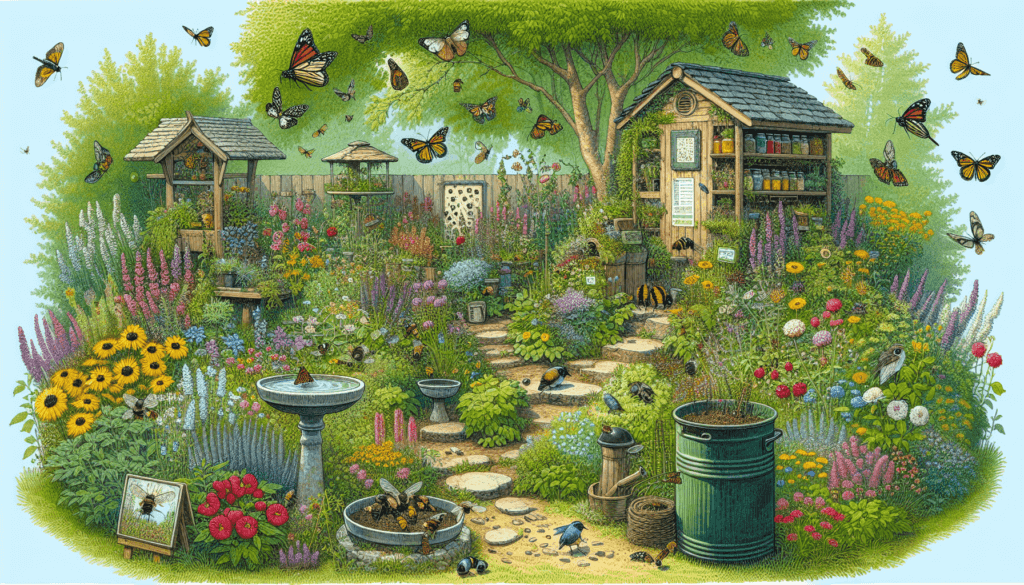Are you looking to create a buzzing oasis in your eco-friendly garden? If so, we have the top tips for attracting pollinators that will transform your space into a haven for bees, butterflies, and hummingbirds. By making a few simple changes, such as choosing the right plants and providing a water source, you can create an inviting environment that will not only benefit the native wildlife but also enhance the beauty and productivity of your garden. Get ready to welcome a symphony of pollinators and experience the joy of watching them dance amidst your vibrant blooms.
Choose Native Plants
Research native plants in your area
When creating an eco-friendly garden that attracts pollinators, it’s crucial to choose native plants. Native plants are those that naturally occur in your specific region and have adapted to thrive in the local climate and soil conditions. To make the most informed choices, take the time to research the native plants in your area. Look for resources from local botanical gardens, nurseries, or gardening organizations that provide information about the native plants that attract pollinators.
Select a variety of native plants
To maximize the attraction of pollinators to your garden, it’s important to select a variety of native plants. Different species of pollinators are attracted to different plants, so by diversifying your selection, you’ll appeal to a wider range of pollinators. Choose a mix of flowers, shrubs, and trees to create a habitat that provides ample food sources and shelter for pollinators throughout the year.
Plant flowers with different blooming times
To ensure a continuous supply of food for pollinators, it’s important to plant flowers with different blooming times. By strategically selecting plants that bloom at different times of the year, you can provide nectar and pollen sources throughout the seasons. This is especially important during early spring and late fall when food sources may be scarce for pollinators. Consider incorporating early bloomers like crocuses and daffodils, as well as late-season flowers like asters and goldenrod.
Provide Shelter and Water
Create habitat with trees and shrubs
Pollinators not only need food sources but also require shelter and nesting sites. Trees and shrubs provide excellent habitat for pollinators like birds, bees, and butterflies. When planning your eco-friendly garden, consider including a variety of native trees and shrubs that provide shelter, nesting sites, and even potential food sources. Examples include oak trees, flowering dogwoods, and butterfly bushes.
Install birdhouses and bee hotels
To further enhance the habitat for pollinators, consider installing birdhouses and bee hotels. These structures provide nesting opportunities for birds and solitary bees, which are essential pollinators. Birdhouses with different sizes of entry holes will attract a variety of bird species, while bee hotels made from natural materials like bamboo or drilled wood blocks can offer suitable nesting sites for solitary bees.
Pools or birdbaths as a water source
Another crucial aspect of attracting pollinators to your garden is providing a water source. Pools, ponds, or even simple birdbaths can serve as water sources for pollinators. Be sure to keep the water source clean and provide stones or floating objects for insects to land on. Adding some shallow edges or water plants can also provide additional habitat for pollinators.

Avoid the Use of Chemicals
Use organic fertilizers and pest control methods
To maintain an eco-friendly garden that supports pollinators, it’s important to avoid using chemicals that can harm them. Instead of synthetic fertilizers, opt for organic alternatives that promote healthy plant growth without compromising the well-being of pollinators. Additionally, choose natural pest control methods like companion planting, insect-repelling plants, or manual removal of pests to avoid pollinator harm.
Avoid pesticides that harm pollinators
Pesticides, especially those containing neonicotinoids, can be extremely harmful to pollinators. These chemicals can remain on plants’ leaves, flowers, and pollen for extended periods, leading to exposure when pollinators visit. It’s crucial to avoid using pesticides that can harm pollinators and instead seek alternative pest control methods that specifically target unwanted pests while sparing beneficial insects.
Practice integrated pest management
Integrated pest management (IPM) is a holistic approach to pest control that focuses on prevention, monitoring, and using a combination of control methods when necessary. By practicing IPM in your garden, you can minimize the impact on pollinators while still addressing pest issues. This approach involves regularly inspecting plants for pests, encouraging natural predators, and utilizing targeted control methods only when necessary.
Create a Diverse Garden
Incorporate different plant heights and textures
Creating a diverse garden with plants of varying heights and textures is essential for attracting a wide range of pollinators. Different pollinators have different preferences when it comes to the plants they visit, and by incorporating a mix of tall plants, ground covers, and everything in between, you can accommodate their needs. This diversity also adds visual interest to your garden, making it a more welcoming and attractive space.
Include a variety of flower shapes and colors
Pollinators are often attracted to flowers based on their shape and color. By including a variety of flower shapes and colors in your garden, you can cater to the preferences of different pollinator species. Some pollinators, like bees, are attracted to tubular-shaped flowers, while others, like butterflies, prefer flat, open flowers. Choose a range of colors, including blues, purples, yellows, and reds, as different pollinators may have preferences for specific hues.
Plant herbs and vegetables for added attraction
In addition to flowering plants, consider incorporating herbs and vegetables into your garden design to provide additional attraction for pollinators. Many herbs, such as lavender, thyme, and mint, produce flowers that are irresistible to bees and butterflies. Vegetables like tomatoes, zucchini, and peppers also produce flowers that can attract pollinators. By including these edible plants, you can create a garden that not only supports pollinators but also provides delicious herbs and vegetables for yourself.

Plant in Clusters
Plant flowers in large clumps
To make it easy for pollinators to find and access the flowers in your garden, it’s beneficial to plant them in large clumps. Clustering flowers together not only makes them more visually appealing but also increases their visibility to pollinators. Instead of scattering individual plants throughout your garden, group them together, creating eye-catching displays that pollinators can easily spot and navigate.
Grouping plants together increases visibility
When pollinators are searching for food, they rely on visual cues to locate flowers. By grouping plants together, you create larger patches of color that are easily visible and attractive to pollinators. This visibility helps them efficiently locate nectar and pollen sources, while also allowing for more efficient pollination of the plants within each cluster.
Clusters allow easy movement for pollinators
By planting flowers in clusters, you provide a convenient pathway for pollinators to move between plants. Clusters create a natural flow of flowers, allowing pollinators to move from one flower to the next without expending excessive energy or time. This ease of movement is especially important for smaller pollinators, like bees, who need to efficiently gather nectar and pollen to sustain themselves.
Provide a Range of Blooming Seasons
Include early spring and late fall bloomers
To support pollinators throughout the year, it’s crucial to include plants that bloom during the early spring and late fall. These periods can be challenging for pollinators to find sufficient food sources, as many plants may not be in bloom. By selecting early bloomers like snowdrops and crocuses, as well as late-season flowers like asters and goldenrod, you can bridge these seasonal gaps and ensure a reliable food supply for pollinators.
Provide nectar sources all year round
Creating a garden that offers nectar sources throughout the year is essential for attracting and supporting a diverse range of pollinators. By carefully selecting plants that bloom at different times and have overlapping flowering periods, you can ensure a consistent nectar supply. This continuity is particularly crucial during times when natural food sources are scarce, such as during periods of extreme weather or habitat disruption.
Ensure continuous food supply for pollinators
In addition to providing nectar sources throughout the year, it’s important to ensure a continuous food supply for pollinators by planting a variety of flowers that bloom sequentially. This means selecting plants with staggered blooming periods so that as one plant finishes flowering, another begins. By carefully planning your garden to include a succession of blooming plants, you can avoid temporary food shortages and provide a reliable food source for pollinators.

Consider Native Bees
Provide nesting sites for solitary bees
While honeybees receive much attention, native bees also play a vital role in pollination. Many native bee species are solitary, nesting individually rather than in hives. To attract and support native bees, provide suitable nesting sites, such as bundles of hollow stems, tunnels in wooden blocks, or specially-designed bee houses. These nesting opportunities are essential for native bees to lay their eggs and ensure the continuation of their populations.
Plant flowers rich in pollen and nectar
Native bees rely on flowers as a source of both pollen and nectar. To attract and support these important pollinators, choose flowers that are rich in both pollen and nectar. Some great options for native bees include sunflowers, black-eyed Susans, coneflowers, and bee balm. These flowers not only provide abundant food sources but also have the added benefit of attracting a wide variety of other pollinators to your garden.
Avoid disturbing native bee habitats
When cultivating an eco-friendly garden, it’s essential to be mindful of existing native bee habitats in your surroundings. Avoid disturbing natural nesting sites, such as bare ground or dead wood, where native bees may already be nesting. By preserving these habitats and minimizing disruption, you can provide a safe and welcoming environment for native bees in your garden.
Attract Butterflies
Choose host plants for caterpillars
Butterflies go through a complete metamorphosis, starting as caterpillars and eventually transforming into beautiful winged adults. To attract and support butterflies in your garden, choose host plants that caterpillars specifically feed on. Different butterfly species have distinct host plant preferences, so research the host plants for the butterflies you want to attract. For example, milkweed is the host plant for monarch butterflies, while parsley is a host plant for swallowtail butterflies.
Include nectar-rich flowers for adults
In addition to host plants, it’s crucial to include nectar-rich flowers to attract butterflies in their adult form. Butterflies rely on nectar as their primary food source, and by planting a variety of flowers with ample nectar, you can create a butterfly-friendly oasis. Flowers like butterfly bush, lavender, coneflowers, and zinnias are all excellent choices for attracting butterflies to your garden.
Create a sunny and sheltered garden
Butterflies thrive in sunny and sheltered environments, so it’s important to design your garden with their needs in mind. Choose a location that receives ample sunlight throughout the day and provides protection from strong winds. Planting taller flowers or adding trellises and fences can help create sheltered areas where butterflies can bask in the sun and seek protection from adverse weather conditions.

Invite Hummingbirds
Plant tubular-shaped flowers
Hummingbirds have long, thin beaks that are perfectly adapted for accessing nectar deep within tubular-shaped flowers. To attract these tiny, vibrant birds to your garden, make sure to include plenty of tubular-shaped flowers. Some popular choices include columbine, salvia, penstemon, and honeysuckle. These flowers not only provide a rich source of nectar but also create a visually stunning display that will undoubtedly attract hummingbirds.
Provide perching spots
Hummingbirds not only visit flowers for nectar but also require perching spots to rest and survey their surroundings. Incorporate plants with sturdy stems or provide additional perching opportunities, such as small branches or trellises. These perching spots allow hummingbirds to take breaks, defend their territory, and conserve energy while visiting your garden.
Offer sugar water or hummingbird feeders
In addition to natural nectar sources, you can also supplement hummingbirds’ diet by offering sugar water or installing hummingbird feeders. Mix a solution of four parts water to one part white granulated sugar and place it in a clean hummingbird feeder. Hang the feeder in a visible location within your garden, ensuring that the solution is regularly changed and the feeder is kept clean to prevent the growth of harmful bacteria.
Maintain a Healthy Garden
Regularly remove weeds and dead plants
A healthy garden benefits both the plants and the pollinators that rely on them. Regularly removing weeds helps prevent competition for resources and reduces the risk of pests and diseases. By keeping your garden free from weeds, you allow your chosen plants to thrive and maximize their ability to attract and support pollinators. Additionally, remove any dead plants promptly, as they can provide ideal breeding grounds for pests and diseases.
Monitor for pests and diseases
Vigilance is key when it comes to maintaining a healthy garden for pollinators. Regularly monitor your plants for signs of pests or diseases, such as chewed leaves, wilting, or discoloration. Early detection allows for prompt action, whether it be manually removing pests, using organic pest control methods, or seeking professional advice if needed. By promptly addressing any issues, you can prevent the spread of pests and diseases that may harm pollinators.
Properly prune and care for your plants
To ensure the longevity and vitality of your plants, proper pruning and care are essential. Regularly prune dead or damaged branches to promote healthy growth and airflow, which can help prevent certain diseases. Follow recommended care instructions for each type of plant, including watering schedules, fertilization methods, and seasonal maintenance. By nurturing your plants, you create a thriving garden that is more likely to attract and support pollinators.
Incorporating these top tips for attracting pollinators to your eco-friendly garden will not only create a beautiful and vibrant space but will also contribute to the important task of supporting pollinators. By choosing native plants, providing shelter and water, avoiding harmful chemicals, creating a diverse garden, planting in clusters, ensuring a range of blooming seasons, considering native bees, attracting butterflies and hummingbirds, and maintaining a healthy garden, you can make a positive impact on the pollinator populations in your area. Start making a difference today by transforming your garden into a haven for pollinators!



